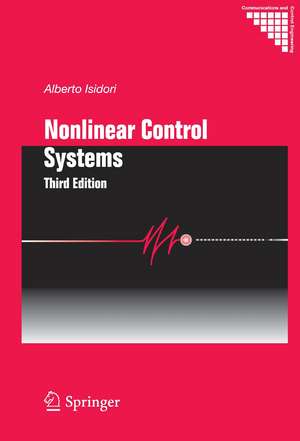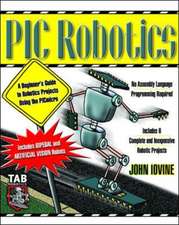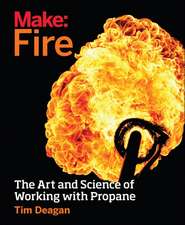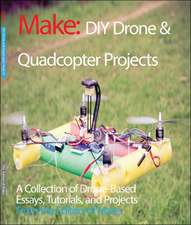Nonlinear Control Systems: Communications and Control Engineering
Autor Alberto Isidorien Limba Engleză Paperback – 3 oct 2013
| Toate formatele și edițiile | Preț | Express |
|---|---|---|
| Paperback (1) | 1392.95 lei 6-8 săpt. | |
| SPRINGER LONDON – 3 oct 2013 | 1392.95 lei 6-8 săpt. | |
| Hardback (1) | 1399.87 lei 6-8 săpt. | |
| SPRINGER LONDON – 11 aug 1995 | 1399.87 lei 6-8 săpt. |
Din seria Communications and Control Engineering
- 18%
 Preț: 953.65 lei
Preț: 953.65 lei - 18%
 Preț: 953.65 lei
Preț: 953.65 lei - 18%
 Preț: 1128.08 lei
Preț: 1128.08 lei - 20%
 Preț: 879.71 lei
Preț: 879.71 lei - 18%
 Preț: 1117.03 lei
Preț: 1117.03 lei - 15%
 Preț: 659.70 lei
Preț: 659.70 lei - 15%
 Preț: 656.89 lei
Preț: 656.89 lei - 18%
 Preț: 896.52 lei
Preț: 896.52 lei - 18%
 Preț: 1113.26 lei
Preț: 1113.26 lei - 18%
 Preț: 1388.22 lei
Preț: 1388.22 lei - 15%
 Preț: 647.27 lei
Preț: 647.27 lei - 18%
 Preț: 954.45 lei
Preț: 954.45 lei - 18%
 Preț: 1231.47 lei
Preț: 1231.47 lei - 18%
 Preț: 948.92 lei
Preț: 948.92 lei - 18%
 Preț: 1232.57 lei
Preț: 1232.57 lei - 15%
 Preț: 643.34 lei
Preț: 643.34 lei - 18%
 Preț: 1127.28 lei
Preț: 1127.28 lei - 18%
 Preț: 1401.30 lei
Preț: 1401.30 lei - 15%
 Preț: 651.51 lei
Preț: 651.51 lei - 20%
 Preț: 1454.07 lei
Preț: 1454.07 lei - 18%
 Preț: 948.79 lei
Preț: 948.79 lei - 18%
 Preț: 1233.06 lei
Preț: 1233.06 lei - 18%
 Preț: 947.85 lei
Preț: 947.85 lei - 18%
 Preț: 950.96 lei
Preț: 950.96 lei - 18%
 Preț: 956.99 lei
Preț: 956.99 lei - 15%
 Preț: 644.18 lei
Preț: 644.18 lei - 18%
 Preț: 946.87 lei
Preț: 946.87 lei - 18%
 Preț: 951.14 lei
Preț: 951.14 lei - 18%
 Preț: 961.55 lei
Preț: 961.55 lei - 15%
 Preț: 644.18 lei
Preț: 644.18 lei - 20%
 Preț: 990.80 lei
Preț: 990.80 lei - 18%
 Preț: 1006.72 lei
Preț: 1006.72 lei - 18%
 Preț: 942.44 lei
Preț: 942.44 lei - 18%
 Preț: 1233.06 lei
Preț: 1233.06 lei - 15%
 Preț: 641.85 lei
Preț: 641.85 lei - 18%
 Preț: 957.75 lei
Preț: 957.75 lei - 15%
 Preț: 649.87 lei
Preț: 649.87 lei - 18%
 Preț: 958.07 lei
Preț: 958.07 lei - 18%
 Preț: 1117.99 lei
Preț: 1117.99 lei - 18%
 Preț: 1395.94 lei
Preț: 1395.94 lei - 18%
 Preț: 781.62 lei
Preț: 781.62 lei - 18%
 Preț: 953.20 lei
Preț: 953.20 lei - 18%
 Preț: 1109.78 lei
Preț: 1109.78 lei - 18%
 Preț: 947.35 lei
Preț: 947.35 lei
Preț: 1392.95 lei
Preț vechi: 1698.72 lei
-18% Nou
Puncte Express: 2089
Preț estimativ în valută:
266.56€ • 275.40$ • 221.74£
266.56€ • 275.40$ • 221.74£
Carte tipărită la comandă
Livrare economică 19 martie-02 aprilie
Preluare comenzi: 021 569.72.76
Specificații
ISBN-13: 9781447139096
ISBN-10: 1447139097
Pagini: 568
Ilustrații: XV, 549 p.
Dimensiuni: 155 x 235 x 30 mm
Greutate: 0.79 kg
Ediția:3rd ed. 1995. Softcover reprint of the original 3rd ed. 1995
Editura: SPRINGER LONDON
Colecția Springer
Seria Communications and Control Engineering
Locul publicării:London, United Kingdom
ISBN-10: 1447139097
Pagini: 568
Ilustrații: XV, 549 p.
Dimensiuni: 155 x 235 x 30 mm
Greutate: 0.79 kg
Ediția:3rd ed. 1995. Softcover reprint of the original 3rd ed. 1995
Editura: SPRINGER LONDON
Colecția Springer
Seria Communications and Control Engineering
Locul publicării:London, United Kingdom
Public țintă
ResearchCuprins
1. Local Decompositions of Control Systems.- 2. Global Decompositions of Control Systems.- 3. Input-Output Maps and Realization Theory.- 4. Elementary Theory of Nonlinear Feedback for Single-Input Single-Output Systems.- 5. Elementary Theory of Nonlinear Feedback for Multi-Input Multi-Output Systems.- 6. Geometric Theory of State Feedback: Tools.- 7. Geometric Theory of Nonlinear Systems: Applications.- 8. Tracking and Regulation.- 9. Global Feedback Design for Single-Input Single-Output Systems.- A. Appendix A.- A.1 Some Facts from Advanced Calculus.- A.2 Some Elementary Notions of Topology.- A.3 Smooth Manifolds.- A.4 Submanifolds.- A.5 Tangent Vectors.- A.6 Vector Fields.- B. Appendix B.- B.1 Center Manifold Theory.- B.2 Some Useful Properties.- B.3 Local Geometric Theory of Singular Perturbations.- Bibliographical Notes.- References.
Recenzii
From the reviews:
Isidori's book is essential for anyone preparing for serious reading or basic research in the differential geometric approach to control theory and will not disappoint those mathematically trained. I have observed its use in the hands of two teachers other than the author; the students enjoyed it and made good use of it later. There is no universal solvent for nonlinear control problems, but the methods presented here are powerful.
IEEE Transactions on Automatic Control 43 (1997) 1043-1044 (Reviewer: David L. Elliott)
Isidori's book is essential for anyone preparing for serious reading or basic research in the differential geometric approach to control theory and will not disappoint those mathematically trained. I have observed its use in the hands of two teachers other than the author; the students enjoyed it and made good use of it later. There is no universal solvent for nonlinear control problems, but the methods presented here are powerful.
IEEE Transactions on Automatic Control 43 (1997) 1043-1044 (Reviewer: David L. Elliott)
Notă biografică
Alberto Isidori was born in Rapallo, Italy. He graduated in electrical engineering from the University of Rome in 1965. In 1969 he obtained a degree equivalent to a doctorate in automatic control from the University of Rome.
Since 1975, he has been Professor of Automatic Control at the University of Rome "La Sapienza". Since 1989, he has also held a position of rofessor (on a half-time basis) at the Department of Systems Science and Mathematics, Washington University, St. Louis, Missouri. He has held visiting positions at several academic institutions, including the University of Illinois (Urbana, Il.), the University of California (Berkeley, Ca.) and the ETH (Zurich, Switzerland).
His research interests are primarily focused on mathematical control theory and control engineering.
In 1979, Alberto Isidori initiated a research program aimed at the extension of so-called "geometric theory" of multivariable linear systems, pioneered in the early 1970s by various authors,to linear systems. Linear algebra and linear geometric methods were replaced in nonlinear systems by the methods of differential geometry, whose usefulness in the study of controllability, observability, and minimality of nonlinear systems had been demonstrated in the early 70s. The main intuition of Isidori was to use differential geometric methods in the synthesis of feedback laws for nonlinear systems, more or less in the same way as linear geometric methods were used in the synthesis of feedback laws for linear systems. The result of this seminal work was the development of systematic methods addressing outstanding design problems like feedback linearization, noninteracting control, disturbance decoupling, and model matching.
From 1985 to 1990 Isidori's research concentrated on the development of the "nonlinear analogue" of the notion of the "zero" of a transfer function. Taking as a point of departure the "geometric" interpretation of this notion, the concept of nonlinear zero dynamics was introduced, studied, and applied. As a result, it was shown that most of the features of the notion of zeros of the transfer function of a linear system are actually manifestations of more general principles. Remarkable examples of application of this theory consisted in the study and the solution of the nonlinear equivalent of the so-called "servomechanism problem" of linear system theory and in the characterization of the conditions for feedback equivalence to a nonlinear passive system.
Since the 90s, Isidori has focused his research interests on problems of disturbance attenuation and robust stabilization of nonlinear systems.
Professional Activities
-President of the European Union Control Association (1995-1997).
-Member of the IFAC Council (1993-1996).
-President-elect of IFAC (three-year term to begin following IFAC World Congress in Seoul 2008)
-On the Editorial Board of: European Journal of Control (since 1995), Automatica (since 1990), IEEE Transactions on Automatic Control (since 1990), International Journal of Control (since 1990), International Journal of Robust and Nonlinear Control (since 1991), Journal of Mathematical Systems, Estimation and Control (since 1991), Mathematics of Control, Signals and Systems (1987-89), Applied Stochastic Models and Data Analysis (since 1985), Systems and Control Letters (1981-88).
Awards and Honors
-Georgio Quazza Medal of IFAC, for ?pionering and fundamental contributions to the theory of nonlinear control,? 1996.
-Fellow of the Institute of Electrical and Electronic Engineers, for ?fundamental contributions to nonlinear control theory?, 1987.
-Outstanding Paper Award for papers published on IEEE Transactions on Automatic Control, in 1981 and in 1990.
-Outstanding Paper Award a paper published on Automatica in1991.
Selected Publications
Nonlinear Control Systems (3rd edition), Springer Verlag (1995), pp. 1-549.
Topics in Control Theory, with W. Knobloch and D. Flockerzi, Berkhauser (1993), pp. 1-166.
Output Regulation of Uncertain Nonlinear Systems, with C.I. Byrnes and F. Delli Priscoli, Birkhauser (1997), pp. 1-122.
Trends in Control Theory (editor), Springer Verlag (1995), pp. 1-422.
Systems, Models and Feedback (co-editor, with T.J. Tarn), Birkhauser (1992), pp. 1-402.
Since 1975, he has been Professor of Automatic Control at the University of Rome "La Sapienza". Since 1989, he has also held a position of rofessor (on a half-time basis) at the Department of Systems Science and Mathematics, Washington University, St. Louis, Missouri. He has held visiting positions at several academic institutions, including the University of Illinois (Urbana, Il.), the University of California (Berkeley, Ca.) and the ETH (Zurich, Switzerland).
His research interests are primarily focused on mathematical control theory and control engineering.
In 1979, Alberto Isidori initiated a research program aimed at the extension of so-called "geometric theory" of multivariable linear systems, pioneered in the early 1970s by various authors,to linear systems. Linear algebra and linear geometric methods were replaced in nonlinear systems by the methods of differential geometry, whose usefulness in the study of controllability, observability, and minimality of nonlinear systems had been demonstrated in the early 70s. The main intuition of Isidori was to use differential geometric methods in the synthesis of feedback laws for nonlinear systems, more or less in the same way as linear geometric methods were used in the synthesis of feedback laws for linear systems. The result of this seminal work was the development of systematic methods addressing outstanding design problems like feedback linearization, noninteracting control, disturbance decoupling, and model matching.
From 1985 to 1990 Isidori's research concentrated on the development of the "nonlinear analogue" of the notion of the "zero" of a transfer function. Taking as a point of departure the "geometric" interpretation of this notion, the concept of nonlinear zero dynamics was introduced, studied, and applied. As a result, it was shown that most of the features of the notion of zeros of the transfer function of a linear system are actually manifestations of more general principles. Remarkable examples of application of this theory consisted in the study and the solution of the nonlinear equivalent of the so-called "servomechanism problem" of linear system theory and in the characterization of the conditions for feedback equivalence to a nonlinear passive system.
Since the 90s, Isidori has focused his research interests on problems of disturbance attenuation and robust stabilization of nonlinear systems.
Professional Activities
-President of the European Union Control Association (1995-1997).
-Member of the IFAC Council (1993-1996).
-President-elect of IFAC (three-year term to begin following IFAC World Congress in Seoul 2008)
-On the Editorial Board of: European Journal of Control (since 1995), Automatica (since 1990), IEEE Transactions on Automatic Control (since 1990), International Journal of Control (since 1990), International Journal of Robust and Nonlinear Control (since 1991), Journal of Mathematical Systems, Estimation and Control (since 1991), Mathematics of Control, Signals and Systems (1987-89), Applied Stochastic Models and Data Analysis (since 1985), Systems and Control Letters (1981-88).
Awards and Honors
-Georgio Quazza Medal of IFAC, for ?pionering and fundamental contributions to the theory of nonlinear control,? 1996.
-Fellow of the Institute of Electrical and Electronic Engineers, for ?fundamental contributions to nonlinear control theory?, 1987.
-Outstanding Paper Award for papers published on IEEE Transactions on Automatic Control, in 1981 and in 1990.
-Outstanding Paper Award a paper published on Automatica in1991.
Selected Publications
Nonlinear Control Systems (3rd edition), Springer Verlag (1995), pp. 1-549.
Topics in Control Theory, with W. Knobloch and D. Flockerzi, Berkhauser (1993), pp. 1-166.
Output Regulation of Uncertain Nonlinear Systems, with C.I. Byrnes and F. Delli Priscoli, Birkhauser (1997), pp. 1-122.
Trends in Control Theory (editor), Springer Verlag (1995), pp. 1-422.
Systems, Models and Feedback (co-editor, with T.J. Tarn), Birkhauser (1992), pp. 1-402.
Textul de pe ultima copertă
This established and authoritative text focuses on the design and analysis of nonlinear control systems. The author considers the latest research results and techniques in this updated and extended edition.
Topics covered include:
• local and global decompositions of control systems;
• input-ouput maps and realization theory;
• nonlinear feedback for single-input/single-output systems and multi-input/multi-output systems;
• applications of state feedback;
• output regulation and
• global stabilization and disturbance attenuation.
Examples are given from mechanical, electrical and aerospace engineering. The approach consists of a rigorous mathematical formulation of control problems and respective methods of solution. The two appendices outline the most important concepts of differential geometry and present some specific data not often found in other standard works. This makes Nonlinear Control Systems suitable as a graduate and undergraduate text and as a source of reference.
Topics covered include:
• local and global decompositions of control systems;
• input-ouput maps and realization theory;
• nonlinear feedback for single-input/single-output systems and multi-input/multi-output systems;
• applications of state feedback;
• output regulation and
• global stabilization and disturbance attenuation.
Examples are given from mechanical, electrical and aerospace engineering. The approach consists of a rigorous mathematical formulation of control problems and respective methods of solution. The two appendices outline the most important concepts of differential geometry and present some specific data not often found in other standard works. This makes Nonlinear Control Systems suitable as a graduate and undergraduate text and as a source of reference.
Caracteristici
A self-contained description of the fundamentals of the theory of non-linear control systems considers the latest research results and techniques in the field. An established and authoritative text Written by one of the most internationally respected figures in this area of control










